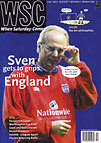 David Montrose asks the question: are grounds really where they say they are?
David Montrose asks the question: are grounds really where they say they are?
Let’s get it straight right now: West Ham do not play at Upton Park. Yes, yes, commentators and journalists may say different; yes, even the players and the manager, going by their public remarks, believe they play there. They don’t. It’s easy, of course, to see how the misconception arose. The team is called West Ham. Obviously, then, West Ham must be where they do their stuff. And this Upton Park you hear about – just has to be the stadium, hasn’t it?
West Ham, though, have never played in West Ham, not even back when the club was Thames Ironworks. Until 1904, their patch was Canning Town: initially Hermit Road, subsequently the Memorial Recreation Ground (which reportedly held 120,000 – pretty impressive for the Southern League). Since then, they have played not at Upton Park but in Upton Park. Because Upton Park – two stops on the tube from West Ham – is a district, the same as Newbury Park to the north and Raynes Park to the south. The stadium where West Ham play is the Boleyn Ground, named after Boleyn Castle, an adjacent 16th century building (demolished in 1955).
XAnd while we’re on the subject, Highbury is also a district of London. Arsenal’s stadium is called, with bold disdain for the predictable, Arsenal Stadium. That’s why Leonard Gribble’s detective novel, published in 1939, was called The Arsenal Stadium Mystery, as was the film adaptation later that year.
Highbury, I suppose, became common usage because football journalists need synonyms. It makes a change to mention events at Stamford Bridge or The Dell instead of writing “Chelsea” or “Southampton” every time. But “Arsenal Stadium” will only incite the sub-editor’s blue pencil. Similar considerations explain, no doubt, why Notts County are said to play at Meadow Lane rather than the County Ground, though how Villa Park caught on is another question.
Still, at least those grounds have names. A surprising number seem to be deficient in that department. While Man Utd certainly play in the Old Trafford area of Stretford and the nearby cricket ground bears that name, their stadium is, to the best of my knowledge, as anonymous as the hero of A Fistful of Dollars. The club gives its address as Sir Matt Busby Way, Old Trafford, not vice-versa.
More usual practice appears to be for a nameless ground to take on the identity of the street where it stands: Elland Road, Bramall Lane, Anfield (“Road” having been deleted), Valley Parade. Sometimes inspiration comes from a greater distance. None of the four streets around Spurs’ ground is White Hart Lane. That road can be found a brief stroll away, across Tottenham High Road. The stadium, though, was built behind the White Hart pub and White Hart Lane is the nearest railway station.
Unnamed grounds tend to date from a time when folk were, I imagine, more casual about such matters. Contrast this with the new stadia of recent years, where naming has been anything but casual: the Cellnet Riverside, the Alfred McAlpine, the Britannia (Stoke). I’m surprised our more lucre-minded clubs have so far ignored the possibilities of changing names. How long, I wonder, before someone concludes that it would be rather nice for Old Trafford to have an official name. Sony Park perhaps. Or what about Microsoft Stadium?X
From WSC 170 April 2001. What was happening this month